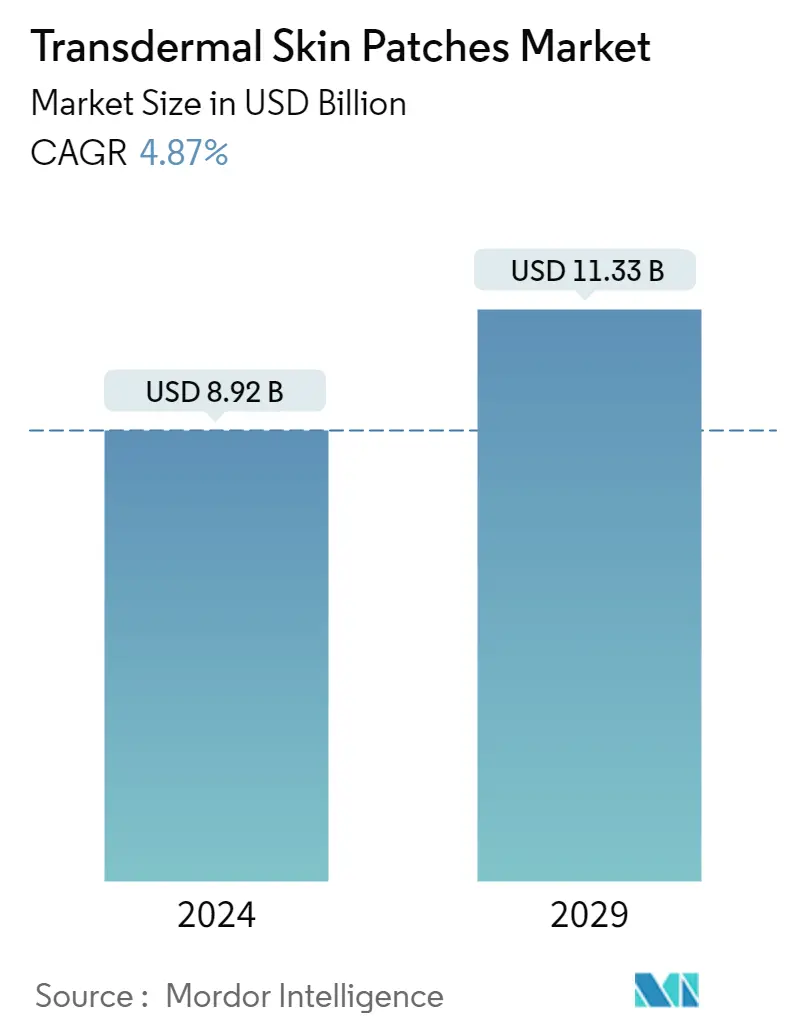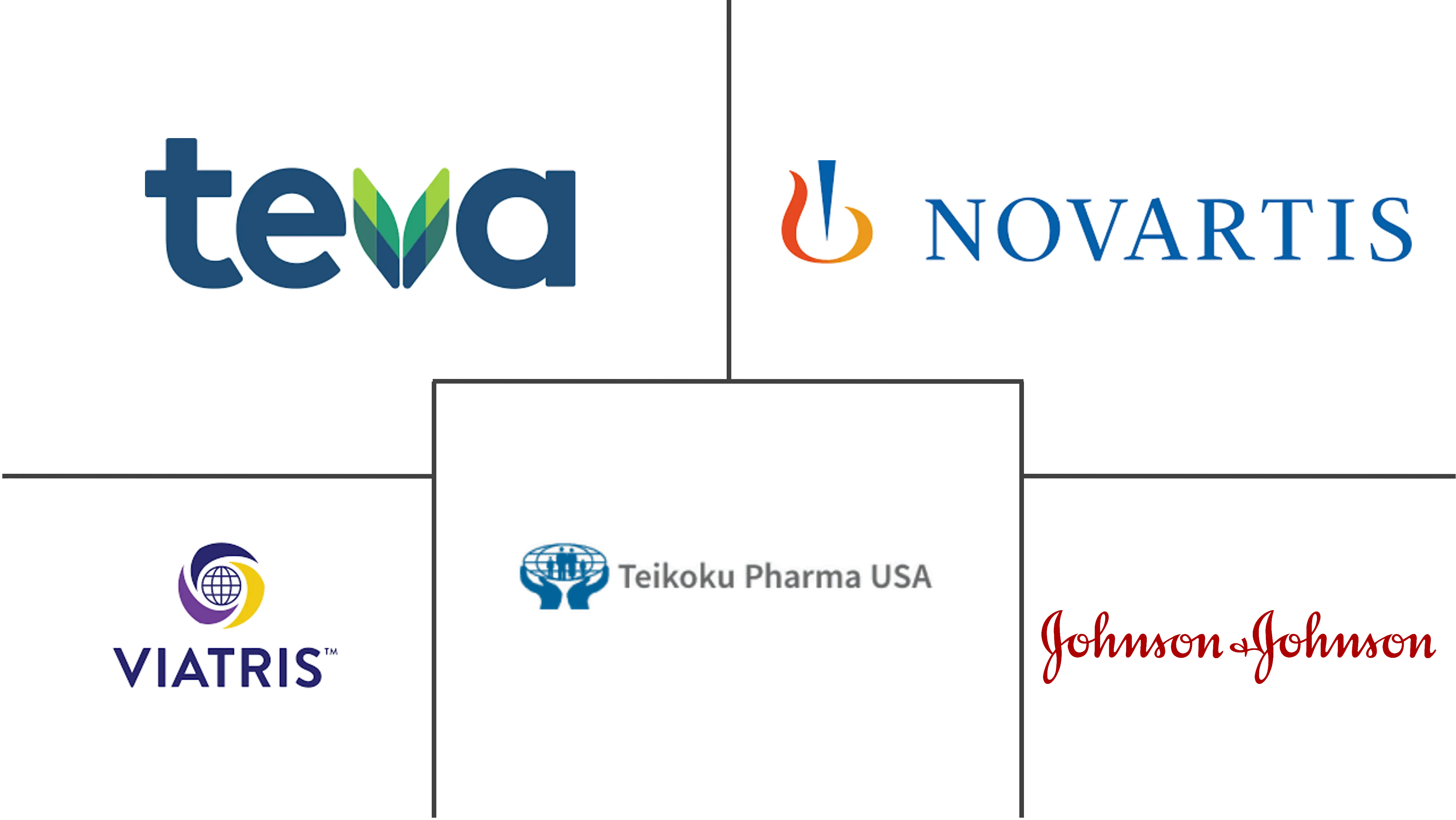Market Size of Transdermal Skin Patches Industry

| Study Period | 2019 - 2029 |
| Market Size (2024) | USD 8.92 Billion |
| Market Size (2029) | USD 11.33 Billion |
| CAGR (2024 - 2029) | 4.87 % |
| Fastest Growing Market | Asia-Pacific |
| Largest Market | North America |
Major Players
*Disclaimer: Major Players sorted in no particular order |
Transdermal Skin Patches Market Analysis
The Transdermal Skin Patches Market size is estimated at USD 8.92 billion in 2024, and is expected to reach USD 11.33 billion by 2029, growing at a CAGR of 4.87% during the forecast period (2024-2029).
The COVID-19 outbreak has impacted the transdermal skin patches market. These patches enable safe, reproducible, and controlled administration of drugs to a defined skin microenvironment. Therefore, researchers working on a potential vaccine against the new COVID-19 strain explored the uses of a fingertip-sized skin patch for delivery. For instance, an article published in May 2020 stated that researchers at the University of Pittsburgh Medical Center and the University of Pittsburgh attempted to develop a microneedle array (MNA), a fingertip-sized patch with 400 microscopic needles that could inject spike protein fragments into the skin.
Additionally, in January 2021, a team at the Swansea University Institute for Innovative Materials, Processing, and Numerical Technologies (IMPACT) produced the COVID-19 smart vaccine patch using microneedles (MNs). The primary goal of this project was to create a prototype of the smart vaccine delivery device that could not only deliver the COVID-19 vaccine transdermal but also monitor biomarkers in the skin compartment in a minimally invasive way, offering real-time information on the efficacy of the vaccination. Hence, COVID-19 has a significant impact on the studied market.
Certain factors attributing to the market growth are the increasing advantages of transdermal medicine over oral and ingesting medications and increasing funding and investments in drug development.
Oral medications can have gastrointestinal adverse effects like nausea or upset stomach. However, digestive side effects can usually be prevented with transdermal patches. For instance, according to an article published in February 2022, it has been observed that the transdermal patch delivers medication directly to the bloodstream through the skin, bypassing the digestive tract and any potential side effects. Transdermal patches, therefore, offer a non-invasive, painless method of drug administration with the added benefit of delivering a continuous therapeutic dose for a specified period. This is expected to increase its adoption among the target population, propelling market growth.
These patches also treat migraine, hormones, pain, cardiovascular diseases, neurology disease, and smoking cessation. Currently, the demand for the transdermal route of the drug delivery system is increasing due to decreased dose frequency, greater bioavailability, reduced side effects, and drug input cessation at any time by removing the patch.
Additionally, the increasing use of tobacco in the form of cigarettes has increased globally over time, creating a healthcare burden. For instance, as per the data published by the WHO data in May 2022, it has been observed that 22.3% of the global population used tobacco in 2021, of which men accounted for 36.7% of the total male population, and women accounted for 7.8% of the world's women population. Therefore, with the increasing number of smokers globally, the usage of nicotine transdermal skin patches and the rising number of patients is expected to boost the market studied.
Furthermore, the growing company's focus on adopting various business strategies such as collaborations, acquisitions, product launches, and others to enter the transdermal patches market contributes to market growth. For instance, in December 2021, Luye Pharma Group announced that their subsidiary Luye Pharma Switzerland AG has agreed with Changchun GeneScience Pharmaceutical Co. Ltd (Gensci) of China, under which the company grants Gensci the exclusive commercialization rights of Rivastigmine Single-Day Transdermal Patch (Rivastigmine SD) and Rivastigmine Multi-Day Transdermal Patch (Rivastigmine MD) on the Chinese mainland. Additionally, in September 2021, ImQuest Biosciences launched its antiretroviral (ARV) transdermal delivery patch. The device utilizes a polymeric patch and film, which releases the drug into the skin over seven days.
Moreover, the increasing awareness among the people for their health and the increasing expendable income leads to high expenditure on healthcare. Also, governments across the globe are investing heavily in drug research. For instance, in October 2021, USFDA awarded 11 grants to clinical trials to develop new medical products for rare disease treatments. Additionally, from the data published by the Canadian government in January 2022, it was found that the public and private sectors invested USD 226,246.5 million and USD 75,208.3 million in developing pharmaceutical drugs, respectively. Such government investments are expected to create opportunities for transdermal medicines or patches, thereby boosting the market growth.
However, the inability of the skin to absorb a range of active substances is expected to hinder the market growth over the forecast period.
Transdermal Skin Patches Industry Segmentation
As per the scope of the report, the transdermal patch is a type of transdermal technology. It is a medicated adhesive patch that is placed on the skin to deliver a precise dose of medication. These patches deliver medicine dosage through the skin using a diffusion technique, which gets released into the bloodstream over a long period. The transdermal skin patches market is segmented by type (single-layer drug-in-adhesive, multi-layer drug-in-adhesive, matrix, and other types), application (pain relief, smoking reduction, and cessation aid, overactive bladder, hormonal therapy, and other applications), and geography (North America, Europe, Asia-Pacific, Middle East & Africa, and South America). The market report also covers the estimated market sizes and trends for 17 countries across major regions globally. The report offers the value in USD million for the above segments.
| By Type | |
| Single-layer Drug-in-Adhesive | |
| Multi-layer Drug-in-Adhesive | |
| Matrix | |
| Other Types |
| By Application | |
| Pain Relief | |
| Smoking Reduction and Cessation Aid | |
| Overactive Bladder | |
| Hormonal Therapy | |
| Other Applications |
| Geography | ||||||||
| ||||||||
| ||||||||
| ||||||||
| ||||||||
|
Transdermal Skin Patches Market Size Summary
The transdermal skin patches market is poised for significant growth over the forecast period, driven by the increasing preference for non-invasive drug delivery methods that bypass gastrointestinal side effects associated with oral medications. These patches offer a controlled and continuous therapeutic dose, making them an attractive option for treating various conditions such as pain, migraines, and cardiovascular diseases. The market's expansion is further supported by the rising prevalence of chronic conditions and the growing demand for nicotine patches due to increased tobacco use globally. Additionally, the market is witnessing heightened activity from companies engaging in strategic collaborations, product launches, and acquisitions to enhance their market presence and drive innovation in transdermal delivery systems.
The impact of COVID-19 has also been notable, with research exploring the use of transdermal patches for vaccine delivery, highlighting their potential in innovative healthcare solutions. Government investments in drug research and development, coupled with increasing healthcare expenditure, are expected to create further opportunities for market growth. However, challenges such as the skin's limited ability to absorb certain active substances may hinder market progress. North America is anticipated to lead the market, supported by a robust healthcare infrastructure and favorable government policies. The competitive landscape remains moderate, with key players focusing on product innovation and strategic partnerships to maintain their market position.
Transdermal Skin Patches Market Size - Table of Contents
-
1. MARKET DYNAMICS
-
1.1 Market Overview
-
1.2 Market Drivers
-
1.2.1 Increasing Advantages of Transdermal Medicine Over Oral and Ingesting Medications
-
1.2.2 Increasing Funding and Investments in Drug Research
-
-
1.3 Market Restraints
-
1.3.1 Inability of the Skin to Absorb a Range of Active Substance
-
-
1.4 Porter's Five Forces Analysis
-
1.4.1 Threat of New Entrants
-
1.4.2 Bargaining Power of Buyers/Consumers
-
1.4.3 Bargaining Power of Suppliers
-
1.4.4 Threat of Substitute Products
-
1.4.5 Intensity of Competitive Rivalry
-
-
-
2. MARKET SEGMENTATION (Market Size by Value - USD million)
-
2.1 By Type
-
2.1.1 Single-layer Drug-in-Adhesive
-
2.1.2 Multi-layer Drug-in-Adhesive
-
2.1.3 Matrix
-
2.1.4 Other Types
-
-
2.2 By Application
-
2.2.1 Pain Relief
-
2.2.2 Smoking Reduction and Cessation Aid
-
2.2.3 Overactive Bladder
-
2.2.4 Hormonal Therapy
-
2.2.5 Other Applications
-
-
2.3 Geography
-
2.3.1 North America
-
2.3.1.1 United States
-
2.3.1.2 Canada
-
2.3.1.3 Mexico
-
-
2.3.2 Europe
-
2.3.2.1 Germany
-
2.3.2.2 United Kingdom
-
2.3.2.3 France
-
2.3.2.4 Italy
-
2.3.2.5 Spain
-
2.3.2.6 Rest of Europe
-
-
2.3.3 Asia-Pacific
-
2.3.3.1 China
-
2.3.3.2 Japan
-
2.3.3.3 India
-
2.3.3.4 Australia
-
2.3.3.5 South Korea
-
2.3.3.6 Rest of Asia-Pacific
-
-
2.3.4 Middle East & Africa
-
2.3.4.1 GCC
-
2.3.4.2 South Africa
-
2.3.4.3 Rest of Middle East & Africa
-
-
2.3.5 South America
-
2.3.5.1 Brazil
-
2.3.5.2 Argentina
-
2.3.5.3 Rest of South America
-
-
-
Transdermal Skin Patches Market Size FAQs
How big is the Transdermal Skin Patches Market?
The Transdermal Skin Patches Market size is expected to reach USD 8.92 billion in 2024 and grow at a CAGR of 4.87% to reach USD 11.33 billion by 2029.
What is the current Transdermal Skin Patches Market size?
In 2024, the Transdermal Skin Patches Market size is expected to reach USD 8.92 billion.

